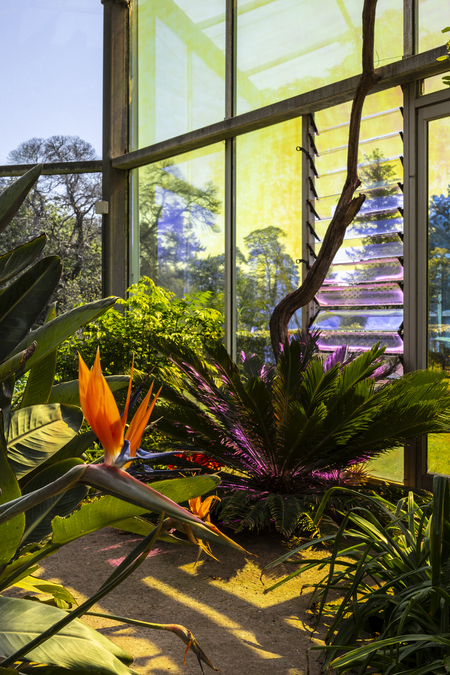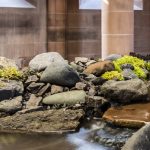We meet Abbas Akhavan to discuss his enchanting site-specific commission at Mount Stuart on the island of Bute
you used to call it blue sometimes by Abbas Akhavan, The Third Line (UAE) and Catriona Jeffries (Canada). Image: Keith Hunter
There is a material fluidity in Abbas Akhavan’s work that mirrors the burns that flow through the grounds of Mount Stuart, where his multi-faceted commission study for a garden reflects upon local topographies and hydrologies using sounds, subtleties and suggestions. The title of the commission embodies the artist’s method of artistic practice as an exploratory, open-ended endeavour that has a critical and intentional engagement with the subject. He uses the term study to enact a liberatory, self-conscious way of working that seeks to look beyond the fixed temporality of the traditional exhibition.
The exhibition unfurls across the buildings and grounds of Mount Stuart, collapsing the boundary between interior and exterior. For his installation variations on a folly, Akhavan has created an 11-metre elevated stream that snakes through the interior of the crypt. The work points to Akhavan’s understanding of the outdoors and indoors as ‘porous’ spaces, and the endurance of the outdoors in our interior worlds.
From here, you are guided out of the house and into the expansive grounds by a 20-minute audio piece that shifts between descriptions of the revelation of sight and the classification of birds. Akhavan talks of the challenge of producing work in a space that is already so saturated with natural and architectural beauty, and how he went about producing works that he says still “merit memory and attention.” Arriving at the octagonal glasshouse, the artist has done this with mesmerising effect, taking the form of a silent video work titled slug, and the installation of dichroic film on the structure’s windows, which alters the viewers’ perception of the internal and the external, and the boundary between the supposedly natural garden and the artificially conjured botanic garden. This installation, titled you used to call it blue sometimes, alongside the audio piece, formulates a multi-sensory, symbiotic reimagining of the natural environment. The artist’s work does not attempt to disrupt or redefine the setting but rather draws attention to elements that may have evaded the viewer. The artist explains that this method of working recasts the artist as author, rather than authority, and is symptomatic of his continued desire to work with the garden.


Akhavan has a strong sense of how his artistic practice operates in relation to site-specificity. He says explicitly that his work, although involving a number of ‘actors’ in its making, is not collaborative. He points to the glaring imbalances and inequalities that are often inherent in collaborative work, where stories are extracted from a community (who are not given recognition or compensated for their work) while the artist, who is essentially a guest in that community, benefits financially. Akhavan’s storytelling challenges this extractive way of working and instead engages democratically with the environment. Recently, the artist has shifted his visual language towards theatre and film sets, and during our conversation, he references various “props” and “actors” that populate his practice.
One of these actors or props is the folly, which Akhavan has a long-standing interest in. Found across the world, but with an abundance in Britain thanks to their fashionability from the 17th century, these decorative structures often mimic more grand, historically important buildings such as Roman ruins, castles and palaces. This concept of the folly as a decorative feature, rather than a fully realised architectural entity, links to the artist’s thinking around the study – as something whose meaning is not necessarily fixed or fully understood. Some may see follies as excessive or superfluous, but Akhavan finds solace in the folly’s self-conscious awareness that they are not ‘real’.
During our conversation, Akhavan references the writing of Elaine Scarry, who informed some of his previous research relating to the contradictions of the domestic space. The etymology of the word ‘house’ is drawn from ‘hos’, which is also the root of the words ‘hospitality’ and ‘hospitable’, but also ‘hostage’ and ‘hostility’. He describes this hostility as extending “beyond the doors to the garden, to the border, to border control.” This term ‘hostile’ inevitably points to Britain’s borders, to the ‘hostile environment’ policy instated by the Conservative government. While this was more of a concern in Akhavan’s previous work, this interest is still evident in the ways that the artist positions himself as a ‘guest’ in a new location, and how he sits in relation to the ‘host’. He describes this as a “negotiation of my own position both as a person who is not of that location, but also as a person who doesn’t want to take too much – as a guest, it involves the learning of a new etiquette.”
Akhavan’s work speaks to wider, global conversations about the imbalanced relationship between humans and nature, a relationship he describes as one of “translation, domestication and control,” where “even its conservation is about potential future extraction of resources for the wealthy in society.” In Akhavan’s commission, the garden becomes the site of this dynamic tension between the human and the natural. Assuringly, his work is seamlessly symbiotic to the natural environment, because it intends to complement it, rather than try to intervene or interfere with it. He says, “the garden for me is this space of transparency around control, about how to balance the imposition of the human on to natural elements. But still, in the end, the hose is the Edenistic snake – the gardener decides what dies and what lives.”



